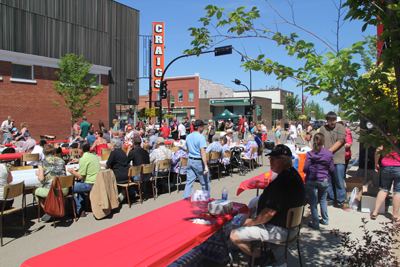Country Canada Founded 1902 Population 4,084 (2016) | Province Alberta Census division 10 Elevation 580 m Local time Sunday 3:30 AM | |
 | ||
Weather 2°C, Wind W at 16 km/h, 88% Humidity | ||
Vermilion is a town in central Alberta, Canada within the County of Vermilion River. It is located at the intersection of Highway 16 (Yellowhead Highway) and Highway 41 (Buffalo Trail), approximately 60 kilometres (37 mi) west of Lloydminster and 192 kilometres (119 mi) east of Edmonton.
Contents
- Map of Vermilion AB Canada
- History
- Demographics
- Economy
- Arts and culture
- Attractions
- Education
- Media
- Notable people
- References
Map of Vermilion, AB, Canada
History
It was not until 1902 that a significant number of settlers arrived in this area of Alberta, mostly of British ethnic background coming from the east. Just west of Vermilion is the line between British and those of Ukrainian ethnic background having travelled mostly from west.
In 1904, a post office was established at Breage approximately 5 km (3.1 mi) east of the present townsite.
In 1905, the Canadian Northern Railway arrived and a station was built. The post office was relocated from Breage. Throughout the days of steam, the railway was important to Vermilion. Vermilion was used as a divisional point. It had a water tower to resupply engines, a large roundhouse, an extensive yard, a wye, a turntable, and a bunkhouse for engine crews. With the decline of steam power in the late 1950s and early 1960s, the railway became less important.
In early 1906, Vermilion was incorporated as a village and then as a town later in the same year. The name Vermilion comes from the red clay found in the river valley. In fact, one of the first businesses in Vermilion was the brick factory which operated from 1906 until 1914. Some Vermilion buildings built from brick from this factory are still standing.
The first newspaper to publish in the Vermilion area was the Vermilion Signal which was founded and edited by William Bleasdell Cameron. (a survivor of the Frog Lake Massacre). In 1909, S.R.P. Cooper established the Vermilion Standard, which continues to publish to this day.
In 1911, the provincial government established three demonstration farms near Olds, Fairview, and just west of the Vermilion townsite. The Vermilion Board of Trade had lobbied the government for a demonstration farm and or college. When the Vermilion School of Agriculture officially opened on November 17, 1913, it became the first of the provincial agricultural colleges to open its door. The Vermilion School of Agriculture has had several name changes in the intervening years including Vermilion Agricultural and Vocational College and Vermilion College before becoming Lakeland College in 1975.
Like other communities on the prairies in the early years of the 20th century, Vermilion experienced an extensive fire. Occurring on April 10, 1918, the fire destroyed 28 stores and business blocks.
Two Vermilion businesses have operated since before the town was incorporated. Craig's, a department store, and Long's, a drugstore, have been at the same downtown locations since 1905.
In the 1970s, an instructor at the college designed a grain dryer. He established a company, Vertec, to manufacture and market this dryer and eventually a large grain dryer factory was built in Vermilion. For a brief time, Vermilion billed itself as "The Grain Dryer Capital of Canada". However, Vertec did not enjoy lasting success and went bankrupt. Today the large former factory is a storage facility for agricultural products.
Demographics
In the 2016 Census of Population conducted by Statistics Canada, the Town of Vermilion recorded a population of 4,084 living in 1,753 of its 1,988 total private dwellings, a 3.9% change from its 2011 population of 3,930. With a land area of 12.93 km2 (4.99 sq mi), it had a population density of 315.9/km2 (818.1/sq mi) in 2016.
The Town of Vermilion's 2012 municipal census counted a population of 4,545, a 1.6% increase over its 2007 municipal census population of 4,472.
In the 2011 Census, the Town of Vermilion had a population of 3,930 living in 1,651 of its 1,845 total dwellings, a -2.6% change from its 2006 population of 4,036. With a land area of 13.69 km2 (5.29 sq mi), it had a population density of 287.1/km2 (743.5/sq mi) in 2011.
Economy
The economy is largely service industry to agriculture.
Arts and culture
The Vermilion Agricultural Society hosts an annual fair which started in 1906. The fair begins with a parade on Thursday morning. The fair lasts a total of three days the last weekend in July.
Attractions
The Vermilion Provincial Park is located on the northwest side of the town. It includes camping, fishing, canoeing and trails for hiking, cycling and cross-country skiing.
Education
The town has two public schools: Vermilion Elementary (K-6) and J.R. Robson Secondary (7-12), and one Catholic school, St. Jerome's School (K-12). The School of Hope, a home school, has its central office in Vermilion.
The town also attracts students from throughout Canada to Lakeland College. Lakeland offers certificate, diploma, applied degree, university transfer, apprenticeship, and pre-employment programs. Programming at the Vermilion campus includes agricultural sciences, business, environmental sciences, fire and emergency response, human services, interior design technology, and trades and technology. Lakeland's residence village is home to more than 500 students.
Media
Vermilion's local weekly newspapers are the Vermilion Standard and the Vermilion and Area Voice.
